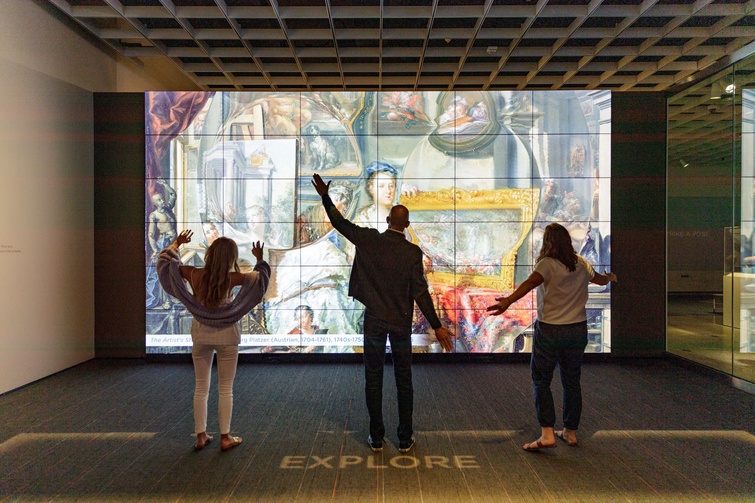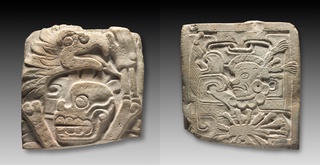Play is Where Art Meets Technology
By Erika Hirugami•December 2020•5 Minute Read

View of The Cleveland Museum of Art's ArtLens Exhibition. Wikimedia Commons / Cleveland Museum of Art. CC BY 4.0.
A friend of mine clued me to the Cleveland Museum of Art‘s ongoing ArtLens exhibition, which pushes the boundaries of how art connects to technology in a truly unique way.
As a vintage millennial who is obsessed with art and technology, I’ve played with all sorts of digital museum initiatives, from the Magic Tate Ball to texting SFMOMA, and follow way too many hashtags on social media. Most often, I’m disappointed by how technology gets in the way of my engagement with art. When the COVID-19 pandemic forced museums across the world to close, I began to yearn for technology to feed my art needs offsite.
During early April, I recall being excited to check out some museum tours from the comfort of my own bed. But that quickly lost its appeal, because most institutions at best provided passive engagement like curator-led walkthroughs or, if I got lucky, a video meeting with an artist or panel of museum professionals. I wanted more—a significantly more involved type of more.
The Cleveland Museum of Art’s ArtLens exhibition pushes the boundaries of how art connects to technology in a truly unique way.
Luckily a friend of mine clued me in to the Cleveland Museum of Art’s ongoing ArtLens exhibition, which pushes the boundaries of how art connects to technology in a truly unique way. On site, the exhibition uses all sorts of technology to allow the visitor to play with the museum’s collection: touch it (digitally), become a part of it (photographically), explore it (upload, sync, and download to your phone), and design it (edit some of the elements). A few of the components of what makes this exhibition extraordinary are available outside the museum, and I am certainly happy I came across them while I pined for art from the safety of home.
View of The Cleveland Museum of Art's ArtLens Exhibition. Wikimedia Commons / Cleveland Museum of Art. CC BY 4.0. Museum visitors interact with an ArtLens Display, which is a gesture-sensing projection system. This display responds seamlessly to body movement and facial recognition, immersing visitors in the experience.
With the use of photogrammetry technology, which creates a three-dimensional scan of the artwork, plus Sketchfab, which hosts the digital content, the Cleveland Museum of Art fulfilled my every tech-artsy desire, and then some. I currently reside in Los Angeles, but, in spite of this physical distance, I am now more familiar with some of the artworks in the collection of the CMA than I am with the collections of most of my local institutions.
With the use of photogrammetry technology, which creates a three-dimensional scan of the artwork, plus Sketchfab, which hosts the digital content, the Cleveland Museum of Art fulfilled my every tech-artsy desire, and then some.
As I toyed around with the CMA’s content, somewhere between Egyptian Pharaoh sculpture heads, Mayan vessels, Hindu Shiva depictions, and Majapahit Dynasty piggy banks, I became immediately captivated by a stela fragment, which is made of limestone and dates back to the classic era of Mesoamerica, between 600–950 CE, potentially from the area of Veracruz in Mexico. This stela has been in the CMA’s collection since 1959 and was originally a gift from James C. and Florence C. Gruener, who purchased it from an antiquities dealer in Dallas. I also learned that this piece has been exhibited twice at the CMA and once more at The Chrysler Museum of Art. This is more information than I typically get at a museum, even if I manage to find an expert on the gallery floor.
A stela is typically a free-standing stone slab carved in relief. One side of this fragment depicts the skull of a being under an eagle’s head. The frontal figures extend in relief to what can be considered the topmost part of the sculpture. The reverse side depicts a human with a feather-like headdress getting ready for battle. The details on the figures of the sculpture show varying levels of relief. Some deeply shadowed portions, carved out using specialized tools, give the impression that the figures sit above the background. Though we know today that stelae (plural of stela) in other parts of the globe were created to commemorate funerals or as governmental notices, the specific purpose for the one at the CMA is unclear, in part due to its condition. The CMA has but a piece of a monumental stela.
I loved that the CMA gave me the agency to flip and rotate this stela, to witness the intricacy of each of its sides from the comfort of my iPad.
Stela Fragment, 600–950. Mexico. The Cleveland Museum of Art. This is another view of the same limestone stela fragment that is possibly from Veracruz.
As if all of this information was not enough, the three-dimensional scan of the sculpture allowed me to see its details up close. Because of the software’s extreme magnifying capabilities, I was able to admire the stone itself, the way texture was transformed by the tools and the cracks that happened as the object moved through time and space. I was able to zoom in and count the scratches on the eyeballs of the figures. I’ve had the privilege to visit multiple archeological sites across Mexico, and am often in awe of the monumentality of even the smallest of fragments. I loved that the CMA gave me the agency to flip and rotate this stela, to witness the intricacy of each of its sides from the comfort of my iPad. One rarely gets to view a stela from above. Engaging with the CMA’s ArtLens quickly became a game for me, one where I could learn vast amounts of information from ancient cultures utilizing some of the most recent technology available. Best use of my screen time ever!
All of the information discussed here is available on the CMA’s website, on Sketchfab, and on the CMA’s ArtLens app, as well as on the Creative Commons. This means you can copy, modify, distribute, and even print the models yourself. While a lot of museums still remain off limits, I can virtually play with the artworks at the CMA—and learn a little art history while doing so.
Erika Hirugami is the founder and CEO of CuratorLove, Co-founder of the UNDOC+Collective, the ED at AHSC, a Professor at CBMArts and SMC, Arts for LA Fellow, NALAC NLI Fellow, and CCI Catalyst. As a Getty and Kress Foundation Fellow, she has developed curatorial statements at museums across Mexico and the United States. After being a Public Art Curator for the Department of Cultural Affairs in the City of Los Angeles, Hirugami became the Curatorial Director for the Ronald McDonald House Charities while leading various commercial galleries. She has curated exhibitions for galleries and museums across the globe, and her written work has been published internationally.
Hirugami is a first-generation transnational Mexican-Japanese immigrant, formerly undocumented. Currently in Los Angeles, California—the unceded land of the Tongva, Tataviam, Serrano, Kizh, and Chumash peoples.
